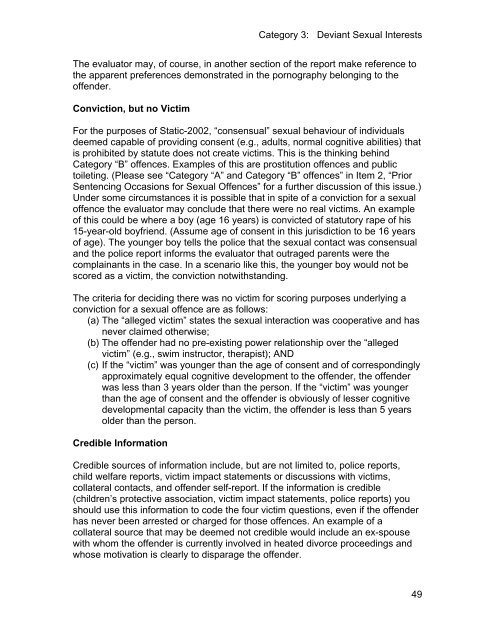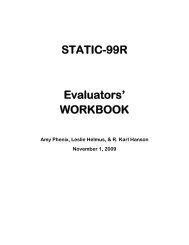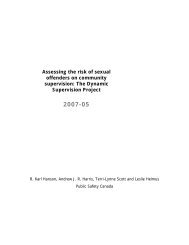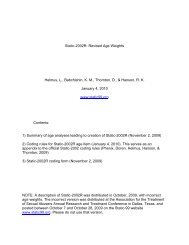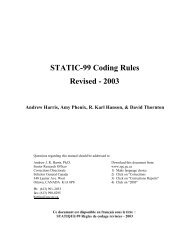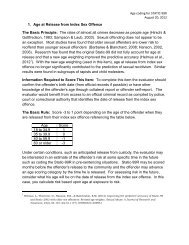Static-2002 coding rules (2009) - Static-99
Static-2002 coding rules (2009) - Static-99
Static-2002 coding rules (2009) - Static-99
You also want an ePaper? Increase the reach of your titles
YUMPU automatically turns print PDFs into web optimized ePapers that Google loves.
Category 3: Deviant Sexual Interests<br />
The evaluator may, of course, in another section of the report make reference to<br />
the apparent preferences demonstrated in the pornography belonging to the<br />
offender.<br />
Conviction, but no Victim<br />
For the purposes of <strong>Static</strong>-<strong>2002</strong>, “consensual” sexual behaviour of individuals<br />
deemed capable of providing consent (e.g., adults, normal cognitive abilities) that<br />
is prohibited by statute does not create victims. This is the thinking behind<br />
Category “B” offences. Examples of this are prostitution offences and public<br />
toileting. (Please see “Category “A” and Category “B” offences” in Item 2, “Prior<br />
Sentencing Occasions for Sexual Offences” for a further discussion of this issue.)<br />
Under some circumstances it is possible that in spite of a conviction for a sexual<br />
offence the evaluator may conclude that there were no real victims. An example<br />
of this could be where a boy (age 16 years) is convicted of statutory rape of his<br />
15-year-old boyfriend. (Assume age of consent in this jurisdiction to be 16 years<br />
of age). The younger boy tells the police that the sexual contact was consensual<br />
and the police report informs the evaluator that outraged parents were the<br />
complainants in the case. In a scenario like this, the younger boy would not be<br />
scored as a victim, the conviction notwithstanding.<br />
The criteria for deciding there was no victim for scoring purposes underlying a<br />
conviction for a sexual offence are as follows:<br />
(a) The “alleged victim” states the sexual interaction was cooperative and has<br />
never claimed otherwise;<br />
(b) The offender had no pre-existing power relationship over the “alleged<br />
victim” (e.g., swim instructor, therapist); AND<br />
(c) If the “victim” was younger than the age of consent and of correspondingly<br />
approximately equal cognitive development to the offender, the offender<br />
was less than 3 years older than the person. If the “victim” was younger<br />
than the age of consent and the offender is obviously of lesser cognitive<br />
developmental capacity than the victim, the offender is less than 5 years<br />
older than the person.<br />
Credible Information<br />
Credible sources of information include, but are not limited to, police reports,<br />
child welfare reports, victim impact statements or discussions with victims,<br />
collateral contacts, and offender self-report. If the information is credible<br />
(children’s protective association, victim impact statements, police reports) you<br />
should use this information to code the four victim questions, even if the offender<br />
has never been arrested or charged for those offences. An example of a<br />
collateral source that may be deemed not credible would include an ex-spouse<br />
with whom the offender is currently involved in heated divorce proceedings and<br />
whose motivation is clearly to disparage the offender.<br />
49


